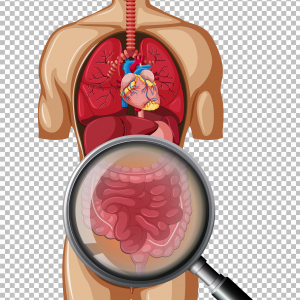The Gut Microbiota: A new era of personalised nutrition?
Within the past 10 years there has been an explosion of studies looking at the role of the gut microbiota and microbiome in health and diseases. The microbiome is the genetic material of the microbiota which is the community of micro-organisms that live on and inside the human body (Valdes, Walter, Segal, & Spector, 2018).
The gut is host to approximately 100 trillion of these micro-organisms; the large majority are bacteria, but also fungi, viruses and protozoa are present (Bull & Plummer, 2014). These micro-organisms perform a large range of different functions including producing a diverse set of metabolites which in turn influences the host health (Bull & Plummer, 2014).
Development of the human microbiota
The development of the microbiota begins at natural child birth. This then continues through breast feeding along with the surrounding environment which colonises the infant’s gut with beneficial bacteria. In the early stages of development, the microbial diversity of the child is low and is mainly formed by two main species, Actinobacteria and Proteobacteria (Rodríguez et al., 2015). About 2,5 years after birth, the infant’s composition and diversity of their microbiome resembles that of an adults (Rodríguez et al., 2015).
What do these microbes do?
The microbiota can digest specific food components that humans are not capable of doing such as dietary fibre. A special set of bacteria utilises the fibre to produce short chain fatty acids (SCFAs) (Wong, de Souza, Kendall, Emam, & Jenkins, 2006). The major SCFAs produced are acetate, propionate and butyrate.
Acetate reaches the peripheral tissue and affects both cholesterol and fatty acid metabolism and can reduce appetite (Frost et al., 2014).
Propionate is transferred to the liver where it regulates both gluconeogenesis, a metabolic pathway that results in the generation of glucose from certain non-carbohydrate carbon substrates. It can also help suppress appetite by interacting with the fatty acid receptor present on the gut (De Vadder et al., 2014).
Butyrateis the main energy source for human colon cells and induces apoptosis of human colon cancer cells (De Vadder et al., 2014).
Other specific products of the gut microbiota that can impact on human health are Indolpropionic acid and the conversion of glucosinolates found in cruciferous vegetables to isothiocyanates.
Indolpropionicis a potent antioxidant which may reduce the risk of type 2 diabetes (de Mello et al., 2017).
Certain isothiocyanates such as Sulforaphane promote detoxification and reduce inflammation (Mithen, Armah, & Traka, 2011).
Microbiota diversity and health
Although it is still not clear what a healthy microbiome consists of, greater microbial diversity is often considered to be a healthy gut. Low bacterial diversity has been associated with several different conditions such as inflammatory bowel diseases (Manichanh et al., 2006), psoriatic arthritis (Scher et al., 2014), type 1 diabetes (de Goffau et al., 2013), obesity (Turnbaugh et al., 2008) and type 2 diabetes (Lambeth et al., 2015).
The transplant of faeces from a lean healthy donor, to the infected patient is now routinely used to treat patients with severe infections such as Clostridium difficle (Schneider et al., 2018). This procedure referred to as faecal microbiota transplantation (FMT) is also currently being explored to treat other pathologies (Kootte et al., 2017).
How does food and medications modulate the microbiota?
The biggest factor that has an impact on our microbiota is diet. For example, sweeteners such as sucralose, aspartame and saccharin, common sugar replacements have been shown to alter the gut microbiota (Bian et al., 2017; Nettleton, Reimer, & Shearer, 2016). Food additives such as emulsifiers commonly found in processed food also affect the gut microbiota of animals such as mice. Mice fed a low concentration of two commonly used emulsifiers: carboxymethylcellulose and polysorbate 80 had reduced microbial diversity compared to mice with no emulsifiers (Chassaing et al., 2015).
Medication also plays a big role. Antibiotics have shown to reduce beneficial species in the gut (Blaser, 2016). Other drugs such as progesterone, TNFα inhibitors and rupatadine also have an impact (Jackson et al., 2015).
What’s the future …
Although we have a better understanding that the microbes in our gut influence our health and that consumption of dietary fibre along with prebiotics is associated with better health, a lot of questions remain unanswered. For example, are microbes responsible for the food choices that we make? Can low doses of antibiotics found in animal products affect our microbiome and in turn our health? Finally, what are the effects of pesticides found in food on the microbiome? Should everyone consume organic food instead?
Having a much better understanding of an individual’s microbiome may lead to personalised nutrition. Given the current limited understanding on how probiotics and/or prebiotics affect the microbiome and whether FMT can ameliorate other diseases such as obesity, more clinical evidence is needed.
myDNAhealth collaborates with the Quadram Institute, a leading institute understanding how food and the gut microbiota are linked in order to promote health and prevent the onset of non-communicable diseases.
Written by: Federico Bernuzzi: BSc in Biochemistry, MSc in Epidemiology and Biostatistics, 2nd Year PhD in Molecular Nutrition at the Quadram Institute
References:
Bian, X., Chi, L., Gao, B., Tu, P., Ru, H., & Lu, K. (2017). Gut Microbiome Response to Sucralose and Its Potential Role in Inducing Liver Inflammation in Mice . Frontiers in Physiology . Retrieved from https://www.frontiersin.org/article/10.3389/fphys.2017.00487
Blaser, M. J. (2016). Antibiotic use and its consequences for the normal microbiome. Science (New York, N.Y.), 352(6285), 544–545. https://doi.org/10.1126/science.aad9358
Bull, M. J., & Plummer, N. T. (2014). Part 1: The Human Gut Microbiome in Health and Disease. Integrative Medicine: A Clinician’s Journal, 13(6), 17–22. Retrieved from http://www.ncbi.nlm.nih.gov/pmc/articles/PMC4566439/
Chassaing, B., Koren, O., Goodrich, J., Poole, A., Srinivasan, S., Ley, R. E., & Gewirtz, A. T. (2015). Dietary emulsifiers impact the mouse gut microbiota promoting colitis and metabolic syndrome. Nature, 519(7541), 92–96. https://doi.org/10.1038/nature14232
de Goffau, M. C., Luopajärvi, K., Knip, M., Ilonen, J., Ruohtula, T., Härkönen, T., … Vaarala, O. (2013). Fecal Microbiota Composition Differs Between Children With β-Cell Autoimmunity and Those Without. Diabetes, 62(4), 1238 LP-1244. Retrieved from http://diabetes.diabetesjournals.org/content/62/4/1238.abstract
de Mello, V. D., Paananen, J., Lindström, J., Lankinen, M. A., Shi, L., Kuusisto, J., … Uusitupa, M. (2017). Indolepropionic acid and novel lipid metabolites are associated with a lower risk of type 2 diabetes in the Finnish Diabetes Prevention Study. Scientific Reports, 7, 46337. Retrieved from http://dx.doi.org/10.1038/srep46337
De Vadder, F., Kovatcheva-Datchary, P., Goncalves, D., Vinera, J., Zitoun, C., Duchampt, A., … Mithieux, G. (2014). Microbiota-Generated Metabolites Promote Metabolic Benefits via Gut-Brain Neural Circuits. https://doi.org/10.1016/j.cell.2013.12.016
Frost, G., Sleeth, M. L., Sahuri-Arisoylu, M., Lizarbe, B., Cerdan, S., Brody, L., … Bell, J. D. (2014). The short-chain fatty acid acetate reduces appetite via a central homeostatic mechanism. Nature Communications, 5, 3611. Retrieved from http://dx.doi.org/10.1038/ncomms4611
Jackson, M. A., Goodrich, J. K., Maxan, M.-E., Freedberg, D. E., Abrams, J. A., Poole, A. C., … Steves, C. J. (2015). Proton pump inhibitors alter the composition of the gut microbiota. Gut. Retrieved from http://gut.bmj.com/content/early/2015/12/30/gutjnl-2015-310861.abstract
Kootte, R. S., Levin, E., Salojärvi, J., Smits, L. P., Hartstra, A. V, Udayappan, S. D., … Nieuwdorp, M. (2017). Improvement of Insulin Sensitivity after Lean Donor Feces in Metabolic Syndrome Is Driven by Baseline Intestinal Microbiota Composition. Cell Metabolism, 26(4), 611–619.e6. https://doi.org/10.1016/j.cmet.2017.09.008
Lambeth, S. M., Carson, T., Lowe, J., Ramaraj, T., Leff, J. W., Luo, L., … Shah, V. O. (2015). Composition, Diversity and Abundance of Gut Microbiome in Prediabetes and Type 2 Diabetes. Journal of Diabetes and Obesity, 2(3), 1–7. https://doi.org/10.15436/2376-0949.15.031
Manichanh, C., Rigottier‐Gois, L., Bonnaud, E., Gloux, K., Pelletier, E., Frangeul, L., … Dore, J. (2006). Reduced diversity of faecal microbiota in Crohn’s disease revealed by a metagenomic approach. Gut, 55(2), 205–211. https://doi.org/10.1136/gut.2005.073817
Mithen, R., Armah, C., & Traka, M. (2011). Cruciferous Vegetables – and Biological Activity of Isothiocyanates and Indoles BT – Vegetables, Whole Grains, and Their Derivatives in Cancer Prevention. In M. Mutanen & A.-M. Pajari (Eds.) (pp. 1–30). Dordrecht: Springer Netherlands. https://doi.org/10.1007/978-90-481-9800-9_1
Nettleton, J. E., Reimer, R. A., & Shearer, J. (2016). Reshaping the gut microbiota: Impact of low calorie sweeteners and the link to insulin resistance? Physiology & Behavior, 164, 488–493. https://doi.org/https://doi.org/10.1016/j.physbeh.2016.04.029
Rodríguez, J. M., Murphy, K., Stanton, C., Ross, R. P., Kober, O. I., Juge, N., … Collado, M. C. (2015). The composition of the gut microbiota throughout life, with an emphasis on early life. Microbial Ecology in Health and Disease, 26, 10.3402/mehd.v26.26050. https://doi.org/10.3402/mehd.v26.26050
Scher, J. U., Ubeda, C., Artacho, A., Attur, M., Isaac, S., Reddy, S. M., … Abramson, S. B. (2014). Decreased Bacterial Diversity Characterizes the Altered Gut Microbiota in Patients With Psoriatic Arthritis, Resembling Dysbiosis in Inflammatory Bowel Disease. Arthritis & Rheumatology, 67(1), 128–139. https://doi.org/10.1002/art.38892
Schneider, K. M., Wirtz, T. H., Kroy, D., Albers, S., Neumann, U. P., Strowig, T., … Trautwein, C. (2018). Successful Fecal Microbiota Transplantation in a Patient with Severe Complicated Clostridium difficile Infection after Liver Transplantation. Case Reports in Gastroenterology, 12(1), 76–84. Retrieved from https://www.karger.com/DOI/10.1159/000481937
Turnbaugh, P. J., Hamady, M., Yatsunenko, T., Cantarel, B. L., Duncan, A., Ley, R. E., … Gordon, J. I. (2008). A core gut microbiome in obese and lean twins. Nature, 457, 480. Retrieved from http://dx.doi.org/10.1038/nature07540
Valdes, A. M., Walter, J., Segal, E., & Spector, T. D. (2018). Role of the gut microbiota in nutrition and health. BMJ, 361. Retrieved from http://www.bmj.com/content/361/bmj.k2179.abstract
Wong, J. M. W., de Souza, R., Kendall, C. W. C., Emam, A., & Jenkins, D. J. A. (2006). Colonic Health: Fermentation and Short Chain Fatty Acids. Journal of Clinical Gastroenterology, 40(3). Retrieved from https://journals.lww.com/jcge/Fulltext/2006/03000/Colonic_Health__Fermentation_and_Short_Chain_Fatty.15.aspx
Click here to add your own text



